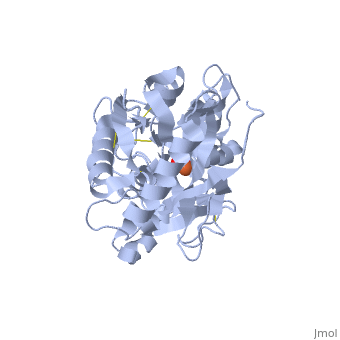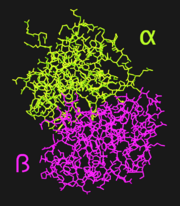Human lactoferrin
From Proteopedia
(Difference between revisions)
| Line 1: | Line 1: | ||
| - | + | <StructureSection load='1dsn' size='450' side='right' scene='' caption='Human lactoferrin complex with Fe and carbonate, [[1dsn]]'> | |
| - | {{STRUCTURE_1dsn|PDB=1dsn|SCENE=}} | ||
=Amino-Terminal Half-Molecule of Human Lactoferrin= | =Amino-Terminal Half-Molecule of Human Lactoferrin= | ||
Human lactoferrin, LF, is a protein in the transferrin family. As such, it has the ability to tightly bind iron in conjunction with a large-scale conformational change associated with iron binding and release.<ref name="faber">PMID:8594202</ref> These properties give lactoferrin the ability to regulate iron, and possibly other metal, ion levels in the fluids and secretions, such as milk, of animals.<ref name="faber" /> Lactoferrin is folded into two lobes: the N-terminal half, LF<sub>N</sub> ([[1dsn]]), and the C-terminal half, LF<sub>C</sub>. The two LF lobes have 37% homology and very similar tertiary structures; it has been suggested that the two lobes are the product of gene duplication.<ref name="farnaud" /> Each lobe of LF<sub>N</sub> is further subdivided into two similarly sized α and β domains (Figure 1); the <scene name='Sandbox_Reserved_302/Ligand_site/1'>iron binding site</scene> is situated in a deep cleft between the two domains.<ref name="faber" /> | Human lactoferrin, LF, is a protein in the transferrin family. As such, it has the ability to tightly bind iron in conjunction with a large-scale conformational change associated with iron binding and release.<ref name="faber">PMID:8594202</ref> These properties give lactoferrin the ability to regulate iron, and possibly other metal, ion levels in the fluids and secretions, such as milk, of animals.<ref name="faber" /> Lactoferrin is folded into two lobes: the N-terminal half, LF<sub>N</sub> ([[1dsn]]), and the C-terminal half, LF<sub>C</sub>. The two LF lobes have 37% homology and very similar tertiary structures; it has been suggested that the two lobes are the product of gene duplication.<ref name="farnaud" /> Each lobe of LF<sub>N</sub> is further subdivided into two similarly sized α and β domains (Figure 1); the <scene name='Sandbox_Reserved_302/Ligand_site/1'>iron binding site</scene> is situated in a deep cleft between the two domains.<ref name="faber" /> | ||
Revision as of 14:10, 21 December 2014
| |||||||||||
Proteopedia Page Contributors and Editors (what is this?)
Karsten Theis, Alexander Berchansky, Michal Harel, Andrea Gorrell


